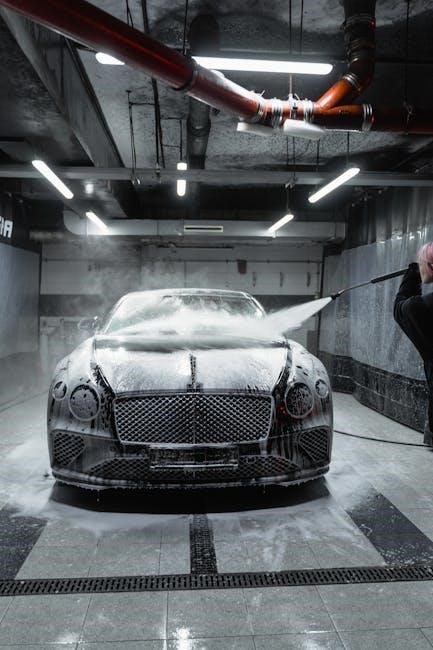car detailing guide
Car detailing is a popular service focusing on thorough vehicle cleaning and protection. It combines therapeutic cleaning with services like ceramic coating‚ offering a polished‚ protected finish and expanding the industry’s reach.
What is Car Detailing?
Car detailing is a meticulous process of cleaning‚ restoring‚ and protecting both the interior and exterior of a vehicle to achieve a showroom-like appearance; It involves specialized techniques and products to enhance the car’s look and maintain its value. From washing and waxing to interior sanitizing and ceramic coating‚ detailing ensures every detail is perfected. It’s not just about cleanliness—it’s about preserving the vehicle’s condition and personalizing its appeal. Whether for daily maintenance or special events‚ detailing offers a therapeutic experience for car enthusiasts‚ transforming their ride into a pristine‚ protected‚ and polished masterpiece.
Importance of Car Detailing
Importance of Car Detailing
Car detailing is essential for maintaining a vehicle’s condition‚ enhancing its appearance‚ and protecting it from environmental factors. Regular detailing preserves the car’s paint‚ interior‚ and overall value‚ while also improving safety by ensuring clear visibility. It prevents damage from contaminants like dirt and UV rays‚ extending the lifespan of materials. Detailing also boosts resale value‚ making a well-maintained car more attractive to buyers. Beyond practical benefits‚ it provides a sense of pride and satisfaction for car owners‚ transforming their vehicle into a polished‚ protected‚ and professional-looking asset. Whether for daily use or special events‚ detailing ensures a car looks its absolute best.
Benefits of Regular Car Detailing
Regular car detailing offers numerous benefits‚ including protection from environmental elements like UV rays and contaminants. It enhances both interior and exterior appearance‚ preserving the vehicle’s condition and value. Detailing extends the lifespan of materials‚ prevents damage‚ and boosts resale value. For car enthusiasts‚ detailing can be therapeutic‚ providing a sense of pride and satisfaction. Regular maintenance also ensures safety by maintaining clear visibility and proper functionality. Additionally‚ a well-detailed car stands out‚ making it more attractive to potential buyers. Overall‚ consistent detailing transforms a vehicle into a polished‚ protected‚ and professional-looking asset‚ whether for daily use or special occasions.
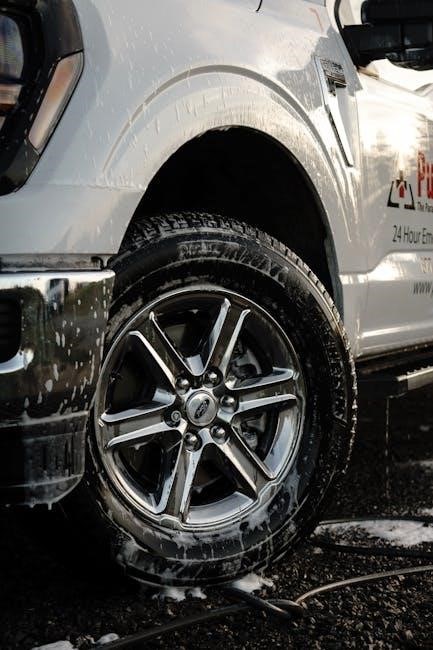
Essential Tools and Supplies for Car Detailing
Key tools include buckets‚ hoses‚ pressure washers‚ microfiber towels‚ detailing brushes‚ clay bars‚ polishing pads‚ and drying towels. These supplies ensure a professional detailing experience.
Basic Equipment Needed
The foundational tools for car detailing include a bucket‚ hose‚ or water source‚ microfiber towels‚ soft-bristle brushes‚ and a detailing spray. A wash mitt or sponge is essential for cleaning surfaces without scratching. Drying towels are crucial for water spot prevention. A vacuum cleaner or handheld vacuum is necessary for interior cleaning. Pressure washers‚ while optional‚ are highly effective for exterior detailing. These basic tools form the starting point for any detailing process‚ ensuring efficiency and effectiveness in maintaining your vehicle’s appearance.
Chemicals and Cleaning Solutions
Essential chemicals for car detailing include car wash soap‚ wheel cleaner‚ glass cleaner‚ and interior cleaners. Car wash soap is formulated to remove dirt without stripping wax. Wheel cleaners target brake dust and grime‚ while glass cleaners provide streak-free clarity. Interior cleaners are gentle on surfaces like leather‚ fabric‚ and plastics. Pre-wax cleaners prepare the paint for waxing‚ and fabric protectants safeguard upholstery from stains. Always use pH-neutral products to avoid damaging materials. Avoid harsh household cleaners‚ as they can harm surfaces. Properly diluted solutions ensure safety and effectiveness‚ making them vital for a detailed finish.
Microfiber Towels and Brushes
Microfiber towels are a must-have for car detailing‚ as they are soft‚ absorbent‚ and lint-free‚ making them ideal for cleaning and drying surfaces. They are used for wiping down exteriors‚ cleaning glass‚ and absorbing water after washing. Brushes‚ such as detailing brushes‚ are essential for reaching tight spaces like air vents‚ trim‚ and crevices. Soft-bristle brushes are perfect for delicate surfaces‚ while stiffer bristles are better for scrubbing wheels or upholstery. Using separate microfiber towels for different areas prevents cross-contamination of dirt and chemicals. Regularly washing and maintaining these tools ensures they remain effective and prevent scratches or damage to vehicle surfaces.

Exterior Car Detailing
Exterior car detailing transforms your vehicle’s appearance by enhancing paint finish‚ removing contaminants‚ and protecting surfaces. Regular detailing prevents damage‚ maintains shine‚ and ensures a professional finish.
Washing Techniques
Proper washing is the foundation of exterior detailing. Start by rinsing the car thoroughly to remove loose dirt. Use a mild car soap with a soft‚ microfiber mitt or sponge‚ avoiding household cleaners that can damage paint. Work in sections‚ from top to bottom‚ using gentle‚ circular motions. Avoid scrubbing too hard‚ as this can create scratches. Use the two-bucket method: one for soapy water and another for clean water to rinse your mitt. Rinse frequently to prevent dirt from being redeposited onto the car. After washing‚ dry the vehicle with a microfiber towel to prevent water spots and ensure a spotless finish.
Clay Bar Treatment
A clay bar treatment is a detailing process that removes contaminants from the vehicle’s paint surface. It effectively eliminates tar‚ bug splatters‚ and overspray‚ leaving the paint smooth. This process enhances the effectiveness of wax or sealant application by ensuring better adhesion. To use a clay bar‚ lubricate it with a detailing spray to prevent scratching. Gently glide the clay over the paint in straight motions. This treatment is crucial for maintaining a pristine appearance and preparing the surface for further detailing steps‚ ultimately resulting in a shinier and more protected finish.
Polishing and Buffing
Polishing and buffing are essential steps in car detailing that restore the paint’s shine and remove imperfections. Polishing uses abrasive compounds to eliminate minor scratches and swirl marks‚ while buffing employs a buffer to smooth the surface and enhance gloss. These processes not only improve the car’s appearance but also prepare the paint for waxing or sealing. Proper techniques and tools‚ like dual-action polishers‚ are crucial to avoid damaging the paint. Regular polishing and buffing maintain the vehicle’s aesthetics and protect its exterior‚ ensuring a flawless finish that stands out on the road.
Waxing and Sealants
Waxing and sealants are crucial for protecting and enhancing your car’s exterior. Wax creates a protective barrier against UV rays‚ water spots‚ and contaminants‚ while sealants provide long-lasting protection. Regular waxing maintains the paint’s glossy finish and prevents oxidation. Sealants‚ often more durable than wax‚ are ideal for daily drivers exposed to harsh conditions; Both products shield the vehicle from environmental damage and make maintenance easier by repelling dirt and water. Applying wax or sealants after polishing ensures a showroom-like finish and prolongs the car’s exterior health. For optimal results‚ reapply these products every few months or after heavy washing.
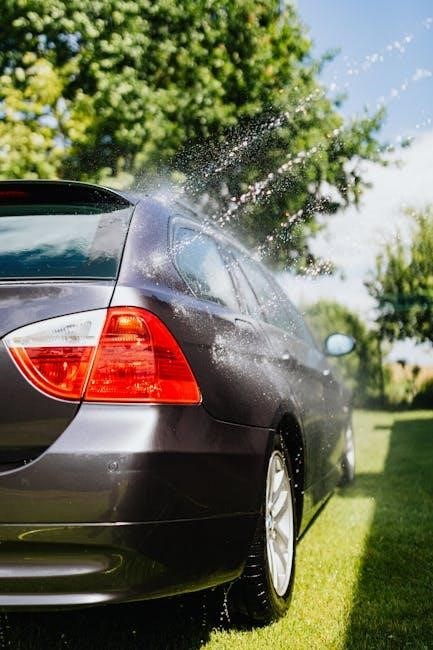
Interior Car Detailing
Interior detailing focuses on deep cleaning and restoring the car’s inside‚ including surfaces‚ upholstery‚ and crevices‚ ensuring a clean‚ hygienic‚ and fresh environment for drivers and passengers.
Vacuuming and Cleaning Surfaces
Vacuuming is the first step in interior detailing‚ removing dirt‚ dust‚ and debris from seats‚ carpets‚ and crevices. Use a vacuum with upholstery and crevice attachments for thorough cleaning. For tough stains‚ pre-treat with a fabric cleaner before vacuuming. Clean surfaces like dashboards‚ consoles‚ and door panels with mild cleaning products and microfiber cloths to avoid scratches. Pay special attention to high-touch areas like steering wheels and gearshifts. Regular vacuuming prevents dirt buildup and maintains a clean‚ fresh interior. For leather surfaces‚ use a gentle leather cleaner to remove dirt without damaging the material. Steam cleaning can be used for deep sanitization and stain removal.
Sanitizing and Deodorizing
Sanitizing and deodorizing are crucial for a fresh and hygienic interior. Use UV-C light sanitizers or steam cleaners to eliminate germs and bacteria on surfaces. For odors‚ apply enzyme-based cleaners to break down organic matter. Sprinkle baking soda on carpets and upholstery‚ let it sit‚ then vacuum for natural deodorizing. Essential oils can also refresh the interior without harsh chemicals. Avoid strong perfumes that linger and attract dust. Regular sanitizing prevents mold growth and keeps the cabin clean. Focus on high-touch areas like seat belts‚ buttons‚ and handles for thorough disinfection. A clean‚ odor-free interior enhances comfort and resale value.
Leather and Fabric Protection
Protecting leather and fabric is essential to maintain their quality and longevity; For leather‚ use a high-quality conditioner to keep it soft and prevent cracking. Apply a leather protectant to repel stains and spills. Avoid using harsh chemicals or excessive water‚ as they can damage the material. For fabric‚ apply a fabric guard to repel dirt and stains. Regularly cleaning spills immediately prevents permanent damage. Use UV protectants on both leather and fabric to prevent fading from sunlight. Proper protection enhances durability‚ maintains aesthetics‚ and ensures a comfortable interior environment. Regular maintenance is key to preserving your car’s upholstery.

Advanced Car Detailing Techniques
Advanced car detailing techniques include paint correction‚ ceramic coating‚ and interior refinement. These methods require precision and specialized tools to achieve flawless results and long-term protection.
Paint Correction
Paint correction is an advanced detailing process that removes imperfections like scratches‚ swirl marks‚ and oxidation from a vehicle’s paint surface. It involves multiple stages‚ starting with a thorough wash and decontamination to prepare the paint. A skilled technician uses specialized tools‚ such as dual-action polishers and buffing pads‚ to carefully refine the paint layer by layer. Compounding and polishing are applied to address deep imperfections‚ followed by finer polishes to restore clarity and gloss. The result is a smooth‚ even finish that enhances the car’s appearance and protects the paint from further damage. Proper techniques ensure long-lasting results.
Ceramic Coating Application
Ceramic coating application is a protective process that enhances your car’s paint durability. Proper preparation is key‚ including a thorough wash‚ decontamination‚ and paint correction. The ceramic coating is then applied in thin‚ even layers using a microfiber applicator. Each layer is allowed to cure‚ usually taking 24-48 hours‚ before the next is applied. This creates a hydrophobic surface that repels water‚ dirt‚ and UV rays‚ reducing the need for frequent waxing. Regular maintenance ensures the coating’s effectiveness and extends its lifespan. Professional application is recommended for optimal results and to avoid any application errors.
Interior Detailing Tips
For a flawless interior‚ focus on organization and precision. Start by removing all personal items and sorting them into categories. Use a microfiber cloth to wipe down surfaces‚ paying attention to high-touch areas like door handles and the steering wheel. Organize cables and wires with clips or ties to maintain a clean look. Apply UV-protectant sprays on leather surfaces to prevent cracking and fading. For fabric seats‚ use a fabric guard to repel stains and spills. Regularly vacuum crevices and upholstery‚ and consider using a deodorizer to eliminate odors. Finally‚ finish with a detailing spray for a polished appearance.
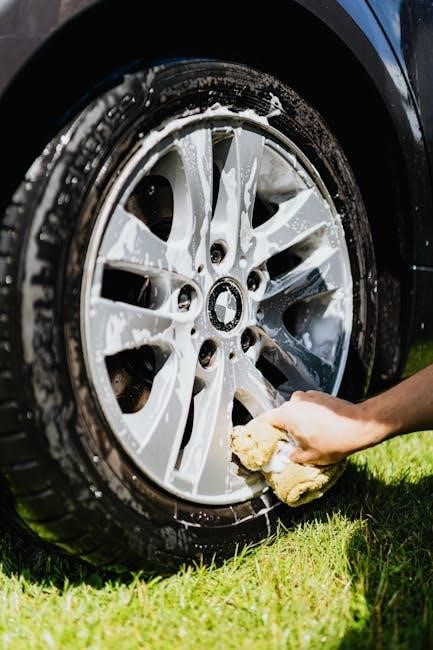
Car Detailing Maintenance Tips
Regular washing‚ waxing‚ and vacuuming are essential. Condition leather and fabric monthly. Inspect for stains and address them promptly. Keep surfaces clean to prevent damage and maintain a polished appearance.
Regular Maintenance Schedule
A consistent maintenance schedule is crucial for preserving your car’s appearance. Wash your car weekly to remove dirt and contaminants. Wax every 2-3 months to protect the paint and maintain shine. Vacuum and clean interior surfaces bi-weekly‚ paying attention to high-touch areas. Condition leather seats monthly to prevent cracking; Inspect tires and trim regularly for damage or fading. Address stains and spills immediately to avoid permanent damage. Schedule professional detailing every 6-12 months for deep cleaning and advanced protection. Stick to this routine to keep your vehicle looking showroom-ready and extend its longevity.
Seasonal Detailing Practices
Adapt your detailing routine to combat seasonal challenges. In spring‚ remove winter grime with a thorough wash and clay bar treatment. Summer heat requires UV-protective wax and frequent cleaning to prevent paint fading. Fall demands attention to leaves and debris—use a clay bar and sealant to shield paint from acidic tree sap. Winter calls for a ceramic coating or heavy wax to protect against snow‚ ice‚ and salt. Regularly clean tires and apply a waterproofing spray to seats. Address seasonal-specific issues promptly to maintain your car’s condition year-round and ensure long-term protection against environmental factors.
DIY vs Professional Detailing
Choosing between DIY and professional detailing depends on your time‚ skill level‚ and desired results. DIY detailing is cost-effective and convenient‚ allowing you to maintain your car’s appearance regularly. However‚ it requires effort and knowledge to achieve professional-quality outcomes. Professional detailers offer expertise‚ advanced tools‚ and superior products‚ ensuring a flawless finish and long-lasting protection. For routine maintenance‚ DIY is practical‚ but for deep cleaning‚ paint correction‚ or specialized treatments‚ professionals are recommended. Assess your needs and budget to decide the best approach for your vehicle’s care and preservation.
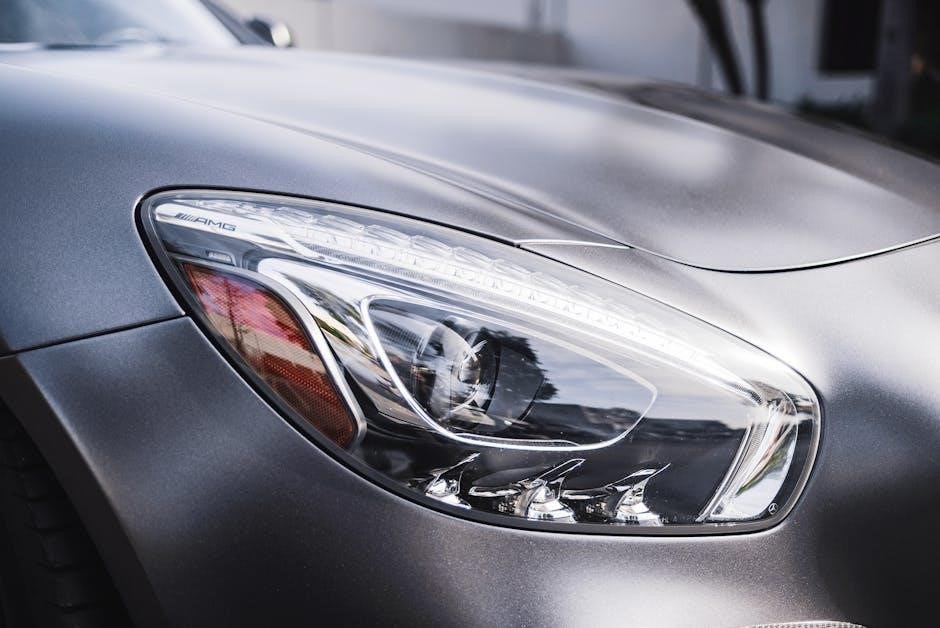
Car Detailing for Specific Vehicle Types
Car detailing varies by vehicle type‚ requiring tailored approaches. Luxury cars need meticulous paint correction and interior care. Classic cars demand gentle cleaning to preserve original finishes. SUVs and trucks benefit from heavy-duty cleaning and protection. Each vehicle type has unique needs‚ making customization key to achieving optimal results.
Detailing for Luxury Cars
Luxury cars require meticulous detailing to maintain their premium appearance. Focus on high-end interior materials like leather and Alcantara‚ using specialized cleaners and conditioners. Paintwork demands precision‚ with advanced techniques like paint correction and ceramic coatings to enhance gloss and protection. Wheels and glass should receive extra attention‚ with protective treatments to resist damage. Interior detailing includes sanitizing and fragrant treatments for a luxurious feel. Regular maintenance prevents wear‚ ensuring the vehicle retains its elegance and resale value. Attention to detail is paramount when handling luxury cars‚ as every aspect contributes to their sophistication and owner satisfaction.
Detailing for Classic Cars
Classic cars require a gentle and preservation-focused approach to detailing. Avoid harsh chemicals that might damage vintage materials. Use mild soaps and soft cloths for exterior washing to protect the paint and chrome. Interior detailing should focus on restoring rather than replacing‚ using period-appropriate products for leather‚ vinyl‚ and carpets. Avoid modern coatings that alter the car’s original look. Regular cleaning and waxing help preserve the finish without over-polishing. Attention to small details like chrome trim and emblems is crucial. The goal is to maintain the car’s historical integrity while enhancing its classic charm for show or drive.
Detailing for SUVs and Trucks
Detailing SUVs and trucks requires attention to their larger surfaces and heavy-duty use. Start with a thorough wash using brushes for hard-to-reach areas like wheel wells. Use robust cleaning products for tires and rims to remove stubborn dirt. The interior often needs extra vacuuming‚ especially in cargo areas‚ and cleaning of durable fabrics or leather. Protect upholstery with waterproofing sprays to withstand spills and wear. Regular detailing helps maintain the vehicle’s functionality and appearance‚ whether for off-road adventures or daily commutes. Focus on practicality and durability to keep these workhorses looking their best.
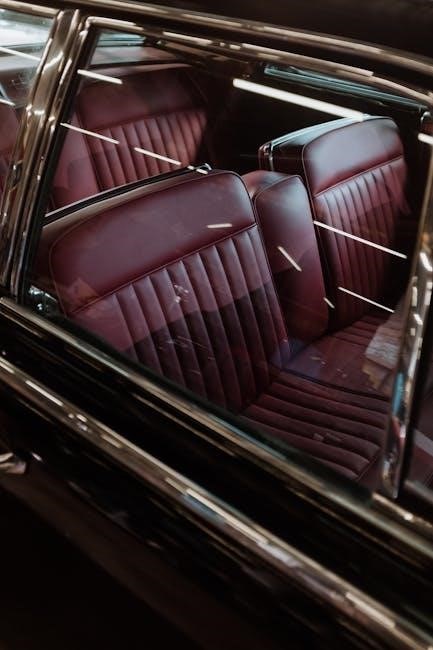
Common Mistakes to Avoid in Car Detailing
- Using household cleaners that damage paint and surfaces.
- Ignoring small scratches and stains that worsen over time.
- Overbuffing‚ which can create swirl marks or thin paint.
- Not rinsing towels properly‚ leading to dirt redeposit.
Overusing Chemicals
Overusing chemicals is a common mistake in car detailing that can damage surfaces. Harsh cleaners strip protective layers‚ causing paint to fade and interiors to wear prematurely. Always use products in moderation and follow instructions.
- Avoid strong detergents that harm wax and sealants.
- Test chemicals on small areas first.
- Choose gentle‚ pH-balanced products for regular use.
Excessive chemical use can lead to dull finishes and cracked leather. Moderation ensures longevity and maintains your vehicle’s appearance.
Improper Washing Techniques
Improper washing techniques can scratch paint and damage surfaces. Avoid using household cleaners‚ as they strip protective wax and dull finishes. Never wash in direct sunlight‚ as it causes soap to dry onto the car‚ leaving streaks.
- Use soft‚ microfiber sponges or mitts to prevent scratches.
- Work from top to bottom to avoid spreading dirt.
- Rinse frequently to remove debris and prevent swirl marks.
Proper rinsing and drying are essential to maintain a clean‚ protected finish and prevent water spots;
Ignoring Small Details
Ignoring small details can significantly impact the overall appearance and protection of your vehicle. Overlooking areas like trim‚ emblems‚ and rubber seals can lead to dirt buildup and damage.
- Use small brushes or detailing swabs to clean tight spaces and crevices.
- Apply specific products for trim‚ tires‚ and glass to maintain their condition.
- Regularly inspect and clean small areas to prevent grime accumulation.
Paying attention to these often-overlooked details ensures a polished look and long-term protection for your car’s surfaces.
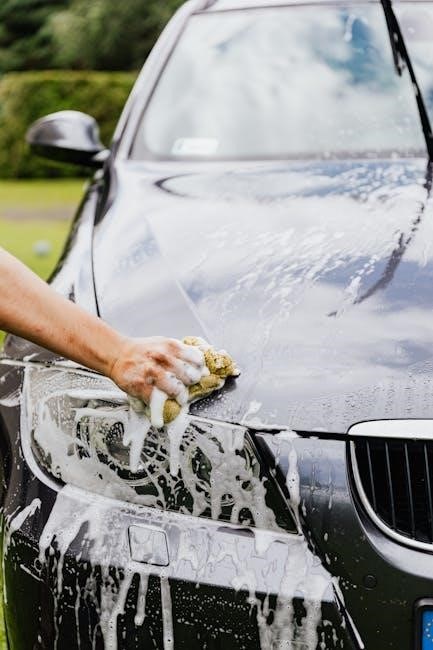
Car Detailing Business Guide
A comprehensive guide to building a successful car detailing business‚ including business plans‚ target audience‚ services‚ pricing‚ and marketing strategies to attract and retain customers.
Starting a Car Detailing Business
Starting a car detailing business requires careful planning and execution. Begin with market research to identify target customers and competitors. Develop a business plan outlining services‚ pricing‚ and operational strategies. Obtain necessary licenses and insurance to operate legally. Invest in essential equipment like pressure washers‚ vacuums‚ and cleaning solutions. Choose a location that is easily accessible and visible. Hire trained staff or start as a solo operation. Build a strong online presence through a website and social media. Offer promotions or discounts to attract initial customers. Focus on quality service to build a loyal client base and positive reputation.
Pricing and Services
Pricing for car detailing services should reflect the time‚ effort‚ and products involved. Basic packages might include exterior washing‚ interior vacuuming‚ and glass cleaning‚ while advanced packages could add polishing‚ waxing‚ or ceramic coating. Consider hourly rates or flat fees based on vehicle size and condition. Offer tiered pricing to cater to different budgets and preferences. Clearly outline services in each package to avoid confusion. Additional services like paint correction or leather conditioning can be sold as add-ons. Create a menu of options to help customers choose based on their needs. Transparent pricing builds trust and attracts repeat business.
Marketing Strategies
Effective marketing strategies are crucial for attracting and retaining customers in the car detailing business. Utilize social media platforms like Instagram and Facebook to showcase before-and-after results‚ creating visual appeal. Develop a professional website with a portfolio and customer testimonials. Leverage email marketing to send newsletters with special offers and detailing tips. Invest in local SEO to increase visibility in search results. Partner with local car washes‚ dealerships‚ or repair shops for referral opportunities. Offer discounts for first-time customers or loyalty programs to encourage repeat business. Word-of-mouth marketing‚ incentivized by referral discounts‚ can also drive growth. Stay consistent and adapt strategies to your target audience.
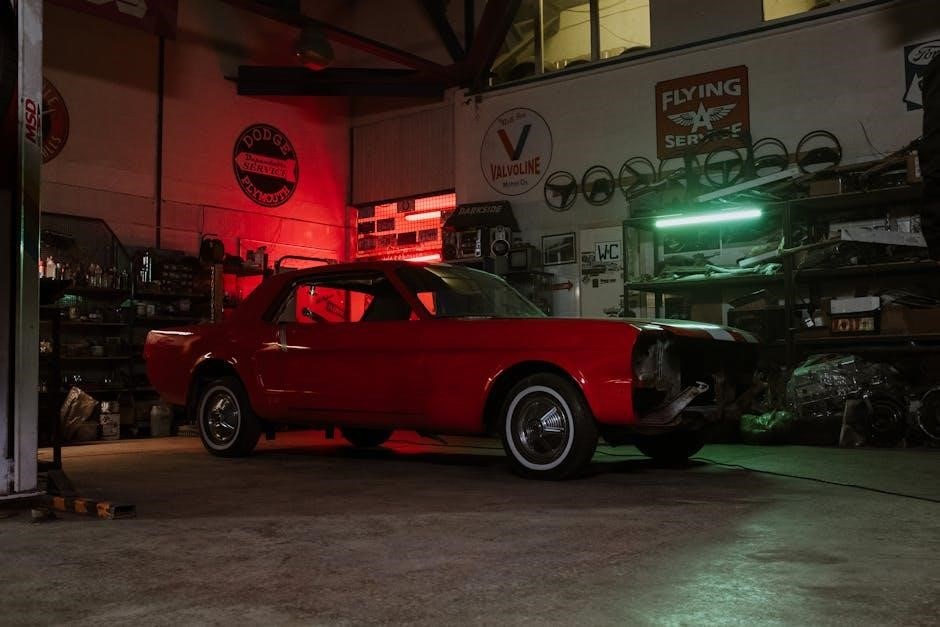
Car Detailing Troubleshooting
Identify common detailing issues like scratches‚ stains‚ or uneven finishes. Use specialized tools and products to address imperfections. Prevent future problems with proper techniques and maintenance.
Fixing Scratches
Fixing scratches is a common car detailing task. Start by assessing the scratch depth. Light scratches may be removed with a polishing compound and a buffer. For deeper scratches‚ sanding may be necessary before polishing. Always work in small‚ circular motions to avoid creating swirl marks. After polishing‚ apply a coat of wax or sealant to protect the surface. For severe scratches‚ professional paint correction may be required. Regular detailing helps prevent scratches by maintaining a protective layer on the paint. Addressing scratches promptly prevents them from becoming more noticeable or causing further damage to the vehicle’s finish.
Removing Stains
Removing stains is a crucial part of car detailing. For interior stains‚ identify the type (food‚ ink‚ grease) and use appropriate cleaners. Blot spills immediately with a clean cloth to prevent them from setting. Avoid rubbing‚ as it can damage fabrics or leather. For tough stains‚ apply a stain remover and let it sit before wiping clean. On exterior surfaces‚ tar‚ bug splatters‚ and sap can be removed with specialized cleaners or a clay bar. Always test a small area first to ensure no damage occurs. Regular cleaning prevents stains from becoming stubborn. Quick action and the right products make stain removal effective and safe for your vehicle’s surfaces.
Correcting Imperfections
Correcting imperfections in car detailing involves addressing minor flaws like scratches‚ swirl marks‚ and paint defects. Start by assessing the depth of the imperfection to determine the appropriate technique. For light scratches‚ a polishing compound or a detailing spray can be used with a buffer or by hand. Deeper scratches may require sanding followed by polishing. Always work in small‚ controlled areas and use clean‚ soft cloths to avoid introducing new imperfections. Regular detailing and protective coatings can help prevent future damage. Proper techniques ensure a smooth‚ even finish‚ restoring your vehicle’s appearance to near-new condition.
Regular car detailing enhances your vehicle’s appearance‚ protects its surfaces‚ and maintains its value. By following proper techniques and schedules‚ you ensure a pristine and long-lasting finish.
Key Takeaways
Regular car detailing is essential for maintaining your vehicle’s appearance and longevity. Always use proper techniques‚ such as gentle washing and precise polishing‚ to avoid damage. Invest in quality tools like microfiber towels and clay bars for optimal results. Protect surfaces with wax or ceramic coatings to shield against environmental factors. Interior detailing is just as important‚ focusing on sanitizing and protecting fabrics or leather. Avoid common mistakes like overusing chemicals or ignoring small details. Consistency is key to preserving your car’s value and ensuring a showroom finish. Professional detailing can offer advanced solutions‚ but DIY efforts‚ when done right‚ are equally effective.
Final Tips for Successful Car Detailing
To achieve a flawless finish‚ always work in a clean‚ shaded environment to prevent contamination. Use high-quality products tailored to your vehicle’s surfaces‚ such as leather conditioners for upholstery or ceramic coatings for paint protection. Regular maintenance is crucial—detail your car every 4-6 weeks to prevent dirt buildup. Avoid using household cleaners‚ as they can damage materials. Inspect your car thoroughly after detailing to ensure no spots are missed. Practice makes perfect‚ so refine your techniques over time. By following these tips‚ you’ll keep your car looking its best and maintain its value for years to come.
